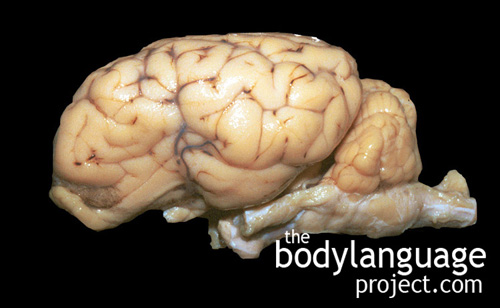 Many theories exist about the human emotional brain. They range from more inward brain centered origins to more reflex or environmental oriented origins. That is, one theory says that emotions come from the inside whereas others say that emotions are created by reacting to what happens in the outside world. Which of the two is correct? Where do our emotions actually come from? How do these related to our body language? We cover these next.
Many theories exist about the human emotional brain. They range from more inward brain centered origins to more reflex or environmental oriented origins. That is, one theory says that emotions come from the inside whereas others say that emotions are created by reacting to what happens in the outside world. Which of the two is correct? Where do our emotions actually come from? How do these related to our body language? We cover these next.
Our amygdala is a part of the brain that has been shown to be the core structure of our emotions and it is closely tied to our body function. The amygdala decodes the information received from our senses and initiates adaptive behaviours through connections to the motor system (our body). Plenty of research shows how this area of the brain is particularly adept at reading facial emotions and decoding them. Other research has identified a structure called the “mirror neuron” found in the brain that triggers a mirror response and causes us to imitate facial expressions. Mirror neurons work regardless of our consciously awareness and in so doing induces us to imitate other people’s expressions. This partially explains why we are negatively affected by people in our company whom persistently scowl or frown. In the long term, negativity usually grates on us to the extent that we often feel a need to actively address others who hold these positions, and if that address proves impossible, we resort to isolating ourselves from them. We do so to protect ourselves from negative and destructive emotions that can permeate our thoughts. Attitudes exempted, even facial expressions of the people we surround ourselves with play a big role on how we tend to see the world. The contagion of negative emotions, thoughts and body language is probably a large player in the recent success of the positive thinking movement. Here, a reverse tact is used to “think” positive, and so be positive, and promises that success and riches will follow.
The brain and body are closely linked and it is difficult to “untie” them from one another. Telling a lie is difficult when holding honest gestures, such as palms exposed, and similarly, it is difficult to have a negative attitude while dancing spryly. The actions the body performs tends to bleed through into the mind and create positive or negative feelings. Even laughing, done for no good reason, can put someone in a good mood because it helps release all sorts of positive hormones.
Body language, for this reason, is very powerful. As we learn the gestures associated with opened and closed minds, we can create positive changes in ourselves. We can even induce emotional changes in others through the use of mirroring, as we shall see in a later chapter. Just by uncrossing the arms, or unfurrowing the brow, can make us not only appear more open and happy, but also make us feel that way. Smiling, even if one is not in the mood, can be particularly effective because it can set the framework by which an interaction might take place. So to provide a quick answer to our initial question, emotions likely have inward and outward forces with varying strengths. With some practice we can either resist outward stimuli, or adopt them, or can induce inward stimuli and emit them. Having the ability to spot reasons for bad moods and body language can allow us to replace them with more positive body language helping us feel happier.
